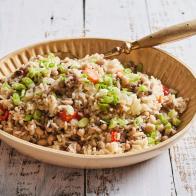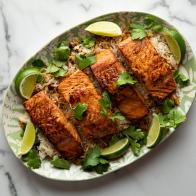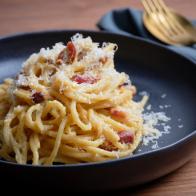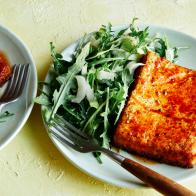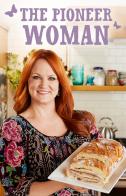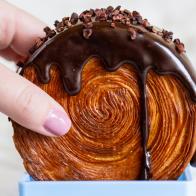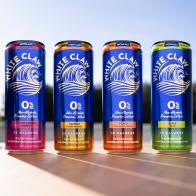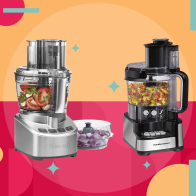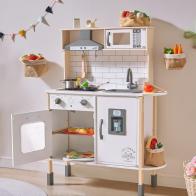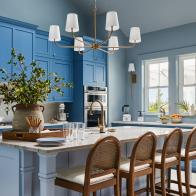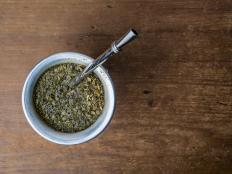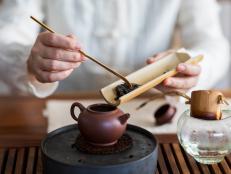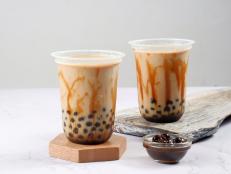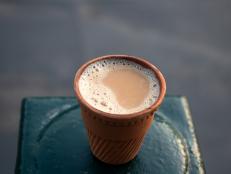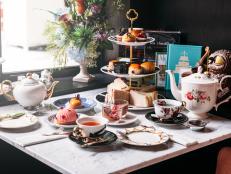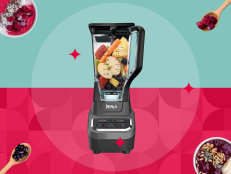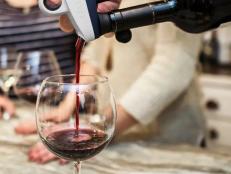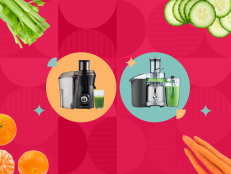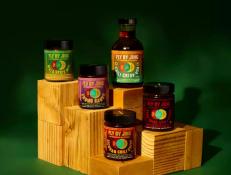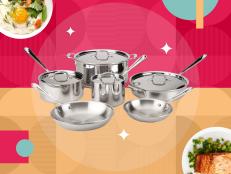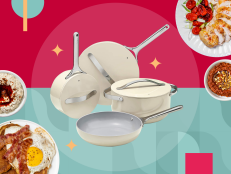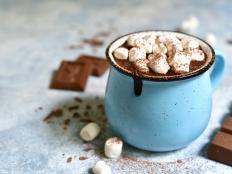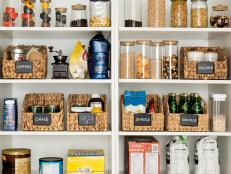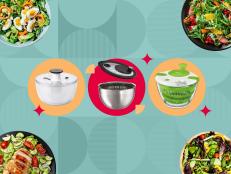A Guide to Tea Etiquette in the Gilded Age
Here's how you'd need to dress, eat and socialize — could you succeed in following all the rules? Plus, the producers of HBO Original The Gilded Age reveal what went into recreating this 19th-century custom in season 2.

Courtesy of Max
Editor’s Note: Max and Food Network are sister brands of parent company Warner Bros. Discovery.
In the American Gilded Age, afternoon teas became very fashionable among both middle-class Americans and wealthy elites. "One of the most significant parts of the tea fascination was that it was English," says Helen Veit, a food historical consultant who worked on HBO Original The Gilded Age — season 2 is now streaming on Max. "Americans loved English things; they loved aristocracy, royalty, country estate, a season, and they incorporated that into Gilded Age life. The fact that tea was so English was a big part of the appeal."
The prevailing notion was that afternoon tea was supposed to be a more of a relaxed get together as compared to other formal occasions of the time. "We think of high tea as such a formal event because our other meals are generally informal," says Luke Harlan, co-producer of The Gilded Age. "But for them, tea was actually quite informal because dinner was a 20-course, black-tie affair every single night. So, tea was actually 'let your hair down' a little."
Even so, afternoon tea in the Gilded Age still came with a set of rituals and etiquette that had to be observed, which informed many of the tea scenes in The Gilded Age — here's a guide to the do's and don'ts.
Know Which Kind of Tea You're Attending
In England, tea could mean a variety of occasions, including an evening meal, a light meal, a scone or toast in the afternoon, or a more formal in-between meal. Veit notes that Americans were also insecure during this time, partly because they were borrowing traditions and didn't always know what to do.
A "tea" in the Gilded Age could mean:
- An open house: The hostess would send cards in advance to let her friends know that she was "at home" at a certain time, say 4 o'clock on Thursday. This way, anyone could drop by for a brief visit, tea and cake.
- A small social gathering: This event was more of a snack before dinner, so the hostess would invite a few friends for 4 or 5 o'clock to chat and have tea and light food, such as cake and toast.
- A high tea: This was more of a meal; it was less formal than a dinner or luncheon but more formal than an open house. Guests gathered around a beautiful table laid with a full spread, and eating was the focus of the gathering.
- A serious party: Both men and women would be invited, and it would be a standing affair with live music, dancing, socializing and a buffet filled with a variety of dishes.

Courtesy of Max
Dress the Part
The wealthiest women changed dresses many times a day. Since teas took place during the afternoon, women in the Gilded Age would wear a beautiful dress, sometimes referred to as "tea dresses." These were similar to "morning dresses," which had higher necklines, but were likely to have more embellishment. "There was an emphasis on 'women are the flowers around the tables,' so dresses were more whimsical," Veit says. "They were less likely to wear grey, dark or brown, more likely to wear lighter colors, depending on the season." Dresses with low necklines were strictly reserved for evening activities like dinner or the opera; you would never wear a dress that showed off the neck, collarbone or cleavage to an afternoon tea.
Leave Your Hat On
Women often kept their hats on during tea. On The Gilded Age "we chose for everyone to wear hats because we had incredible milliners working on the show," Harlan says. "The hostess would not wear a hat because it's her house. There were rules around tiaras at parties; married women would wear tiaras but unmarried women would not."
RSVP and Consider "Tea-Hopping"
If the tea was more of an open house, Veit says, you wouldn't have to RSVP and you could just stop by for a brief visit. If there was more than one open house on a given afternoon, women could "tea-hop" from one to another. If it was more of a sit-down meal, the timing on the invitation would note a time for sitting down. Because all the various types of tea parties became so popular in the 1880s and 1890s, Veit says that some women complained that they were often obliged to go to multiple teas in one afternoon, and that it became tiring.

Courtesy of Max
Be Prepared for One-Upmanship
"Because Americans didn't really know what to do, they were just trying to copy and imitate so they one-upped one another all the time," Harlan says. "They could always do a little bit extra." Harlan reveals that one of The Gilded Age season 1's major scenes was the "war of the butlers." "The old-money van Rhijns already had a way of serving things or doing things British style; they had a British butler. When Bertha was trying to prove herself in this new society and insert herself, she tries to do it that way, but times 100," Harlan says. "How do we serve the English way and do it in a way that society accepts and prove that we are part of it?"
Take Your Own Seat
High tea, or a sit-down tea, was the most common kind of tea party during the Gilded Age. But even though it was a sit-down affair, the informality of afternoon tea meant that guests could seat themselves. "One thing that set tea apart from a luncheon or dinner is that they didn't proceed formally to the table," Veit says. "There wouldn't have been place cards at a tea – it was a widely accepted rule. It was supposed to be less formal; because of this, it was seen as fun."

Courtesy of Max
The Hostess Must Choose the Right Tea Pot and Cups
Each house had different tea pots and serving sets for different tea occasions. The Gilded Age has a dedicated props department responsible for creating the food and drink scenes. A beautiful tea pot or tea kettle was a must, especially silver for those who could afford it. The tea service sets would be fine china or porcelain, particularly Dresden, an opulent brand of porcelain teacups and saucers. Veit notes that during the Gilded Age, many houses used European-style cups with handles, but Asian-style cups without handles (and sometimes with a fitted lid on top to retain heat) were also trendy.
Black Tea Was In, Green Tea Was Out
Black tea was in style, so one or more varieties of black, loose-leaf tea would be served. Green tea was out of style, though some people still served it, but no one would serve herbal teas since they didn't include real tea leaves. Varieties of fine black tea frequently included Pekoe or Orange Pekoe, but Veit notes that other varieties were served, including Souchong, Bohea, Formosa Oolong, or Formosa Flower Oolong. "When choosing teas, advice-givers talked at least as much about the importance of using a tea with a pleasant aroma as a pleasant taste," Veit notes. "Being close to the aroma of brewing tea was another reason people made the tea at the table instead of having it made in another room."
Leave the Tea Preparation to the Hostess
The tea-making ritual was at the center of the gathering and it was always the hostess's domain, so she sat by the tea urn. "She would pour hot water from the urn into the teapot, let it steep for a specific amount of time, then pour it into cups," Veit says. Veit notes that the serving order could have important implications: the hostess might often serve the oldest woman first as a sign of respect, or she might single out the most socially significant woman by serving her first.
Guests would be offered sugar (by the spoonful, not cubes) and cream, but usually not milk, Veit notes. It also became trendy to serve lemon slices and Gilded Age Americans dubbed tea with lemon "Russian Tea." In summer, cracked ice was sometimes offered along with strong, hot tea so that guests could make their own iced tea.
Say Yes to Coffee If You Wish
Americans were major coffee drinkers at this time, so serving coffee at afternoon tea was also common. "Coffee and sometimes even thick hot chocolate were also served," Veit says.

Courtesy of Max
Always Act Right-Handed
Even if you were left-handed, you still had to use your right hand during the Gilded Age; this was a rule that Harlan extended to the actors on set when sipping tea. "In general, they really didn't approve of left-handedness, so you would write with your right hand and do most things with your right hand," Veit says.
Be Prepared for a Variety of Foods
Veit shares that people sometimes compared high teas to a late breakfast, or what we would call afternoon brunch, so the spread might include a mix of sweet and savory foods. "One thing surprising was, yes, there are scones, and wafers, and light cookie-type things, but much more than that too," Veit says. "All sorts of cakes, biscuits, tea sandwiches, and tea cakes, but also waffles, muffins, buttered toast and all sorts of meat, potentially — roast turkey, ham, chicken, beef, other sandwiches, pickles, oysters, lobster salad, fish, fried patties. It was not just scones and tea sandwiches."
Help Yourself, But Don't Appear Eager to Eat
Wealthy elite were expected to have rigid posture, eat slowly and carefully and to appear not seeming eager to eat. One of the defining characteristics of high tea is that all the food would be laid out on the table and guests could help themselves. This was in stark contrast to luncheons or dinners where servants would pass dishes. "Once everything was out, servants would leave; people would serve themselves," Veit says. "That would be like us going to a farm and picking our own strawberries. 'Oh, we're doing manual work, preparing it ourselves.'"

Courtesy of Max
Taking Seconds Is Okay, But Don't Clean Your Plate
Since guests could help themselves, they could take seconds. "Elite eaters at a tea would almost certainly not clean their plates, but an eater could also select another sandwich/croquette/cake, etc. as they were eating," Veit says. "Eaters — especially ladies — wouldn't take massive portions, but they wouldn't have starved themselves either. Eating moderately was much more about seeming self-controlled and not seeming to need the food, and not about dieting or weight loss, which wasn't really on anyone's radar yet." Napkin etiquette for women dictated that they use their napkins only occasionally, and that they very carefully and delicately dabbed at their mouths.
Consider (and Love) the Oyster
Veit shares that Gilded Age Americans loved oysters. Throughout her research, almost every description of high teas mentions oysters. There could be different types of oysters served, including raw oysters, scalloped oysters, fried oysters or "oyster pats" (like a crab cake-esque dish made with oyster meat).
Don't Draw Attention to Yourself If You're Not the Hostess
"There's almost a way of making sure you never draw attention," Harlan says, "unless you have something very important to say." Veit adds: "Even with the tea where there was so much attention paid to the food, it wasn't like today where it's kind of like foodie-ism, 'what are the ingredients? What went into this?'" If you spilled tea or cream, the general rule was that you paid minimal attention or no attention to it at all. "The servant could deal with that later. You don't add to the problem by noticing it," Veit says.
Related Links:
